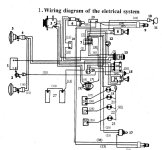Herein lies the logical falacy:
As should be now clear, neither is fused. But the keyswitch is.
They are both fed of fthe key switch which is fused.. thus BOTH are fused circuits.... to test this.. remove the fuse fro the key switch and neither circuit will work if they are fed of fthe key switch.. thus the system fuse is a material series component to the parallel circuits fed of of it.
If the key switch is fused, and other circuits are fed of fthe key switch.. then ALL circuits are fused.
IE.. if you have a series circuit wtih parallel legs, and the series circuit is fused.. ALL parallel circuits are protected by the common fuse (feeding the key switch, in this case.)
Here is an exact analogy:
Look at your house wireing.. You have 1 breaker ( or fuse ) for each room ( or zone ) in many cases.. both receps and hard wired lamps. The receps and lamps are protected by the fuse/breaker. If you walk in a room and plug in a hair dryer... the hair dryer is ALSO protected by the same breaker that protects the recep it is plugged into. Just because there is no fuse inthe line to the hair dryer does not mean, that in an electrical sense, that it is unprotected.
When yuo chart out a complex parallel circuit with series components, you can actually make a bunch of simple series circuits out of each parallel circuit in order to make it easier to understand.. In this case.. the fuse would be par of the series circuit, and thus COMMON to all of the parallel circuits.
Thus.. if the key switch is fused.. anything comeing from the key switch is also fused... that's 9th grade intro electronics 101 basic AC and DC circuits. I have managed to keep every electronics book I used in school/college for each course I took... and this stuff I discussed right here is chapter 3.. chapter 1 being ohms law theory, and chapter 2 being components. chapter 3 being basic ac/dc circuit starting with simple circuit design.
If you can put your pencil on the schematic and travel from the + battery terminal, thru a fuse, then thru a load, then to ground.. that circuit is protected... don't matter about intervening switches.
An exception exists for relay driven loads.... if the starter key switch, drives a relay for the glow plugs, and the source for the relay power contact is not fused, then only the load ( relay coil ) is fused... and the glow plugs, like the starter, are unfused.
Really simple stuff..
Soundguy
